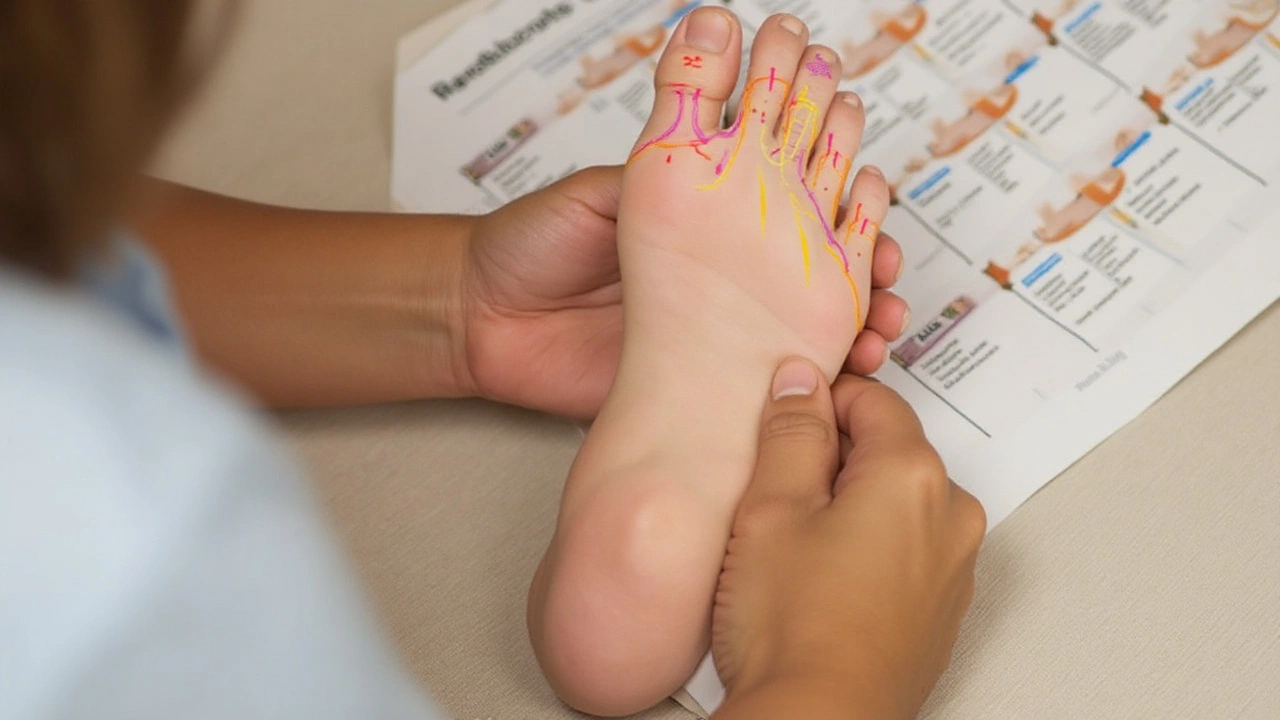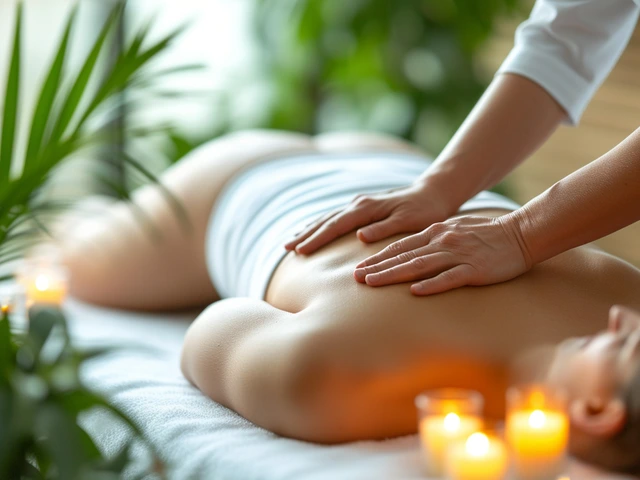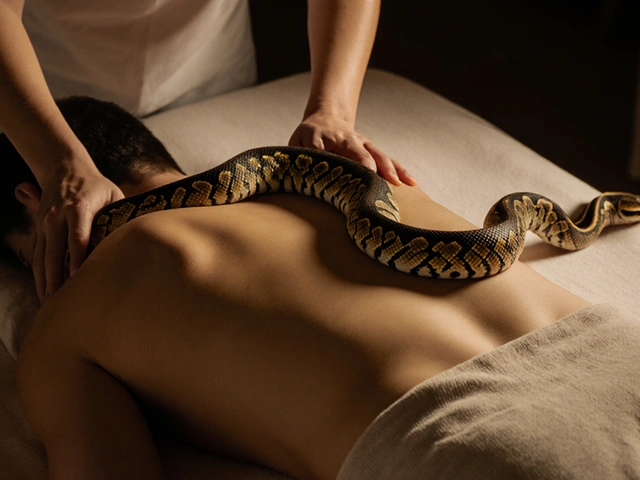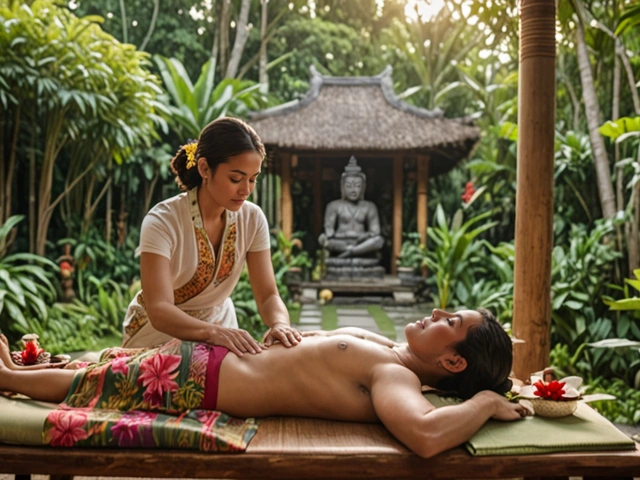Unveiling the Wonders of Reflexology for Natural Healing

Discover the fascinating world of reflexology, a practice that connects specific points on your feet, hands, and ears to various organs and systems in your body. This ancient therapy is more than just a foot massage; it's a pathway to holistic well-being.
By applying pressure to specific areas, reflexologists aim to balance energy, reduce stress, and promote overall health. Whether you're curious about its history or looking for practical ways to include it in your daily routine, this article sheds light on how reflexology can be a powerful tool for natural healing.
Join us as we delve into the essential aspects of reflexology, from its roots in ancient civilizations to modern techniques and benefits. Ready to take your first step towards understanding and experiencing reflexology? Let's begin!
- What is Reflexology?
- A Brief History of Reflexology
- Health Benefits of Reflexology
- Popular Reflexology Techniques
- Tips for Practicing Reflexology at Home
- Finding a Qualified Reflexologist
What is Reflexology?
Reflexology is a therapeutic practice based on the principle that specific points on the feet, hands, and ears are connected to various parts of the body. These points, known as reflex points, correspond to different organs, glands, and systems. By applying pressure to these reflex points, reflexologists aim to improve overall health, alleviate pain, reduce stress, and promote relaxation. The practice of reflexology goes beyond the surface level, delving into the interconnectedness of the body and mind.
The fundamental idea behind reflexology is that it supports the body's self-healing processes. These reflex points are believed to send signals to the corresponding body parts when stimulated. This stimulation helps to clear any blockages in the flow of energy within the body, enhancing circulation and encouraging the body's natural healing abilities. Many people find reflexology to be a comforting experience, not only because it targets physical pain but also because it provides mental and emotional relief.
Reflex Points and Their Connections
In reflexology, practitioners often use maps of the feet, hands, and ears to guide their practice. These maps illustrate how different zones on these areas of the body correspond to specific organs and systems. For example, the tips of the toes are thought to connect to the head, while the arch of the foot is linked to the digestive organs. This mapping system allows reflexologists to target precise areas depending on a client's symptoms or health complaints. Interestingly, reflexology sessions often reveal tender spots on the feet or hands that correspond to imbalances or problems in the related body parts, bringing attention to issues that may not have been previously noticed.
Reflexology is not just a modern phenomenon. It has deep roots in ancient cultures, with evidence suggesting that some form of reflexology was practiced in ancient Egypt, China, and India. These early forms of reflexology may have varied in technique and underlying philosophy, but they all shared a common belief in the interconnectedness of the body's various systems and the potential for healing through pressure points. This historical continuity adds to the credibility and allure of reflexology, drawing people who are interested in alternative healing practices with ancient origins.
"By addressing the feet, hands, and ears, reflexology presents a non-invasive way to promote wellness and target specific health concerns," says Laura Norman, a renowned reflexologist and author.
Modern Reflexology Practices
Modern reflexologists often blend traditional techniques with contemporary understanding of physiology to provide effective treatments. Sessions usually last between 30 to 60 minutes and can be tailored to address specific health issues, such as migraines, digestive troubles, or hormonal imbalances. During a session, the reflexologist will assess the client's feet, hands, or ears and apply varying degrees of pressure to the reflex points. Each session is unique, as the practitioner will adjust their approach based on the client's feedback and reactions. Over time, many people report significant improvements in their health and well-being, attributing these changes to the consistent practice of reflexology.
For those new to reflexology, it can be a fascinating journey into a form of therapy that feels both ancient and contemporary. As interest in holistic and alternative treatments grows, reflexology offers a unique way to explore the body-mind connection and discover new paths to health and healing.
A Brief History of Reflexology
Reflexology has roots that trace back to ancient civilizations, where it was practiced as part of traditional medicine. Historians believe the earliest records of this therapy come from Egypt. A pictograph found in the tomb of an Egyptian physician, Ankmahor, dating back to 2330 BCE, shows practitioners working on the feet and hands of others. This early evidence suggests that Egyptians may have recognized the healing potential of reflexology thousands of years ago.
Meanwhile, in China, reflexology dates back to 2704 BCE, when Dr. Wang-Wei pioneered its therapeutic use. The ancient Chinese book 'Huangdi Neijing' also references the system of pressure points and their link to various parts of the body. The Chinese medicine technique aimed to balance the body's energy, or 'Qi,' which they believed flowed through specific pathways.
Similarly, Native American tribes, especially the Cherokee, practiced a form of reflexology that involved manipulating the feet to promote healing. They passed down their knowledge and methods through generations, indicating that the roots of foot therapy were widespread and culturally significant.
In the modern era, Dr. William H. Fitzgerald, an American ear, nose, and throat specialist, is credited with introducing reflexology to the West in the early 20th century. He developed 'Zone Therapy,' which divided the body into ten vertical zones and suggested that pressure on specific points in these zones could alleviate pain and tension. As he published his findings in various medical journals, the wider medical community began to take interest.
A bit later, Eunice Ingham, a physiotherapist, built on Dr. Fitzgerald's work in the 1930s. She extensively mapped the reflex zones on the feet and hands, creating detailed charts that are still used by reflexologists today. Her book, 'Stories the Feet Can Tell,' played a pivotal role in popularizing reflexology as a holistic therapy.
Even into the 21st century, reflexology continues to evolve. Countries such as the United Kingdom and the United States have seen the development of professional associations, training programs, and certifications to ensure the practice is well-regulated and respected. The therapy's integration into complementary and alternative medicine has grown, with many people today seeking reflexology for its numerous potential benefits.
According to the International Institute of Reflexology, "Reflexology is based on the principle that there are reflexes in the feet and hands which correspond to every organ, gland, and part of the body." It’s an idea that transcends time and cultures, proving the enduring nature of this ancient healing art.
So reflexology’s history is rich and varied, spanning continents and millennia. From ancient Egypt and China to Native American tribes and modern Western medicine, this therapy has evolved and adapted, indicating its long-standing significance and potential for promoting well-being.

Health Benefits of Reflexology
Reflexology has been gaining traction as a complementary therapy that can offer numerous health benefits. While it might seem like a standard foot massage to the uninitiated, it involves applying pressure to specific points on the feet that correspond with different organs and systems in the body. One of the most significant benefits associated with reflexology is stress reduction. By targeting specific points, reflexologists aim to alleviate tension and help balance the body's energy, which contributes to improved relaxation and a sense of well-being.
Another major benefit is pain relief. Whether you suffer from chronic pain conditions like arthritis or want some relief after a strenuous day, reflexology can be a natural alternative to conventional pain relievers. Some studies even support that reflexology can help with postoperative recovery by reducing pain and speeding up the healing process.
Moreover, reflexology is known to improve circulation. By stimulating the flow of blood, it ensures that your body cells receive enough oxygen and nutrients. This improved circulation can boost energy levels and help eliminate toxins more efficiently. Reflexologists often focus on points that are said to enhance the function of particular organs, such as the heart and kidneys, further promoting overall health.
Reflexology can also have a positive impact on mental health. Regular sessions can help reduce symptoms of anxiety and depression. The calming experience provides an opportunity for the mind and body to relax, often creating a meditative state that enhances emotional well-being. Some proponents argue that reflexology can balance hormones and assist with conditions such as PMS and menopause.
Immune system boosting is another incredible benefit. By stimulating certain reflex points, practitioners believe they can enhance the body's ability to fend off infections and illnesses. This potentially includes everything from the common cold to more severe health conditions. This boost in immunity works hand-in-hand with detoxification processes that cleans and rids the body of unwanted substances.
Individuals with digestive disorders may also find relief through reflexology. Reflex points that connect to the stomach, intestines, and other parts of the digestive system can help alleviate issues like indigestion, constipation, and bloating. Testimonials suggest that regular sessions improve overall digestive health and promote better nutrient absorption.
As Dr. Edwin Neblett, a board-certified reflexologist, puts it, “Reflexology can activate the healing power within us. With targeted pressure on reflex points, the body can begin its natural repair processes.”
Lastly, reflexology can serve as a complementary therapy for people with severe ailments. While it should never replace conventional medical treatments, its supportive role can bring about an improved quality of life, especially for those dealing with complex or chronic conditions. Scientific research on reflexology is ongoing, but many people report noticeable improvements after several sessions, lending credence to its potential benefits.
Popular Reflexology Techniques
Reflexology offers a variety of techniques designed to target specific areas on your feet, hands, and ears. These techniques are not just random pressure points; they are carefully chosen to correspond to different organs and systems in the body. Understanding these techniques can truly enhance your experience and bring significant benefits to your health and well-being.
One of the most common techniques is the thumb walking. This method involves using the thumb to apply pressure in a rolling motion over specific areas of the foot. The thumb walking technique is often used to stimulate digestion, improve circulation, and relieve stress. It’s a technique that combines firm pressure with gentle movements, making it both effective and soothing.
Finger walking is another popular method. Similar to thumb walking, this technique uses the fingers to press and roll over targeted areas. Finger walking is often applied to smaller or more sensitive areas, such as the hands and ears. By skillfully manipulating the fingers, reflexologists can address concerns like headaches, sinus issues, and even emotional imbalances.
In addition to walking techniques, the hook and backup method is frequently used. This technique involves hooking the thumb or finger onto a specific point and then backing up slightly to apply deeper pressure. The hook and backup method is particularly effective for areas needing more intensive stimulation, such as the spine or kidneys.
According to Barbara Kunz, a noted reflexologist, “The hook and backup technique is incredibly powerful for releasing tension and promoting overall balance in the body.”
Reflexology also employs the use of rotations. This involves rotating the fingers or thumbs in a circular motion over a specific point. Rotations are especially useful for addressing chronic pain and stimulating lymphatic drainage. They help break down blockages and encourage the flow of energy, making them a staple in reflexology sessions.
Learning these popular techniques can be quite empowering. If you're looking to try reflexology at home, here are some simple steps:
- Relax
- Warm-up
- Start with Thumb Walking
- Move to Finger Walking
- Try Hook and Backup
- Finish with Rotations
Sit in a comfortable position. Take a few deep breaths to help you relax before starting.
Rub your hands or feet together to warm them up. This can enhance the effectiveness of the techniques.
Use your thumb to apply pressure in a walking motion over the soles of your feet. Pay attention to any sensitive areas, as these might indicate places that need more attention.
Switch to using your fingers to press and roll over the tops of your feet or your hands. Take your time and be gentle with sensitive areas.
Find a point that feels particularly tense or sore. Hook your thumb or finger onto it and press deeply, then back off slightly and repeat.
Perform small circular motions with your thumbs or fingers over any areas that still feel tense. This can help to further relax and soothe these spots.
Combining these techniques can provide a comprehensive and rewarding reflexology experience. Practice regularly to get the best results, and don't be afraid to experiment with different pressures and motions to see what works best for you. As with any form of alternative therapy, consistency and patience are key to achieving the maximum benefits from reflexology.

Tips for Practicing Reflexology at Home
Practicing reflexology at home can be a rewarding experience that promotes relaxation and well-being. To start, it is essential to understand the basic techniques and pressure points. If you are new to reflexology, investing time in learning can pave the way for effective self-care. Books, online courses, and reflexology charts can be valuable resources in familiarizing yourself with this practice.
Begin by selecting a quiet and comfortable space in your home. This can help you focus and enhance the therapeutic effects of reflexology. It is also important to maintain a calm and positive mindset. Start with clean feet and hands to ensure the best results. Use lotion or oil for a smoother and more enjoyable experience.
The thumb-walking technique is a common method used in reflexology. By applying steady pressure using your thumbs, you can work on various reflex points. Start from the toes and move toward the heel, covering the entire foot. Remember to be gentle and avoid applying excessive force to prevent discomfort or injury.
Incorporating reflexology into your daily routine can be easier with a set schedule. You can designate a specific time for this practice, such as before bedtime, to help with relaxation and sleep. Practicing for about 10-15 minutes per session can be beneficial. With consistency, you may notice improvements in your health and well-being.
Using reflexology tools, such as foot rollers or massage balls, can enhance your at-home practice. These tools can target specific areas and provide deeper stimulation. Experimenting with different tools can help you find the ones that work best for you. Additionally, heated tools can provide warmth and further relaxation during the session.
Keeping a reflexology journal can be helpful in monitoring your progress. You can note down the areas you worked on, the techniques used, and any changes you observe in your health. This practice can also help you identify patterns and tailor your sessions to address specific concerns.
If reflexology is being used to address a specific health condition, it is advisable to consult with a professional reflexologist or healthcare provider. They can offer guidance and ensure that your practice is safe and effective. While self-care is important, professional advice can provide a well-rounded approach to your health.
Remember, the goal of reflexology is to promote balance and relaxation. It is meant to complement other health practices and should not replace medical treatment. Practicing reflexology with mindfulness and consistency can contribute to your overall well-being and enhance your quality of life.
"Reflexology has been found to aid in relaxation and alleviate stress, which can have a profound impact on overall health," says Dr. Jane Logan, a certified reflexologist. "It's a simple yet effective practice that can be easily incorporated into one's routine."
Finding a Qualified Reflexologist
Locating a qualified reflexologist is crucial for reaping the benefits of this ancient therapy. This quest starts with understanding what makes a reflexologist stand out. An essential factor is proper training. A certified reflexologist typically has completed coursework from an accredited institution, covering anatomy, physiology, and various reflexology techniques.
One helpful tip is to check credentials. In many regions, reflexologists must be certified by a professional body, such as the American Reflexology Certification Board (ARCB) in the United States. Verify memberships and certifications to ensure they meet the professional standards. Ask about their training, educational background, and years of experience. If possible, seek out reviews or testimonials from previous clients.
Communication skills are another important aspect. A good reflexologist should listen to your concerns, ask about your medical history, and explain how their sessions could benefit you. They should also provide a clear plan tailored to your needs. Initial consultations can often give you a sense of their professionalism and approach.
Reflexologists often specialize in various techniques. Some may focus on foot reflexology, while others might include hands and ears. Discuss these options and choose someone whose methods align with your preferences and needs. Always feel comfortable asking questions about their specific expertise and the benefits of different techniques.
Word of mouth remains a powerful tool. Ask friends, family, or healthcare providers for recommendations. People with firsthand experience can offer invaluable insights into the effectiveness and demeanor of specific practitioners. Online forums and social media groups dedicated to wellness and alternative therapies can also be useful resources for recommendations and reviews.
Visiting the clinic beforehand can also be beneficial. Check if the environment is clean, comfortable, and relaxing. The ambiance plays a significant role in the overall experience, contributing to relaxation and the effectiveness of the therapy. Pay attention to the staff's friendliness and professionalism during your visit.
It's also important to consider logistics. Choose a reflexologist whose location and working hours fit comfortably with your schedule. Regular sessions are often necessary to achieve lasting benefits, so convenience can be a significant factor in maintaining consistency with treatment.
Lastly, trust your instincts. Your comfort and security are paramount. If something feels off during your initial interactions or consultation, it might be best to continue your search until you find someone you are entirely comfortable with. Seeking out a qualified reflexologist is a step towards better health, so take your time to choose the right professional who can guide you on this journey.





